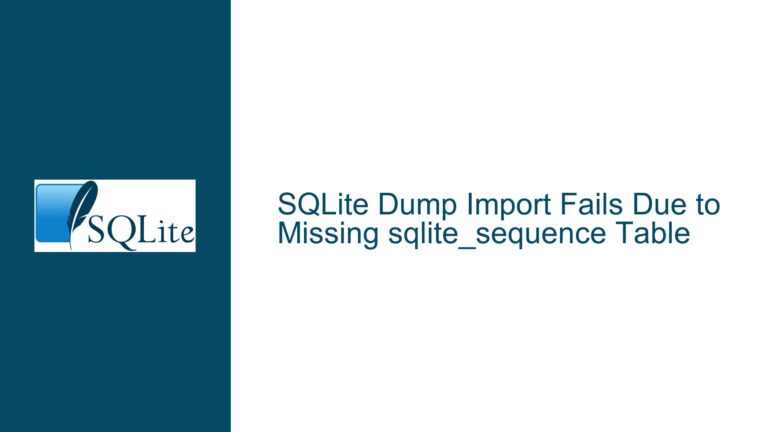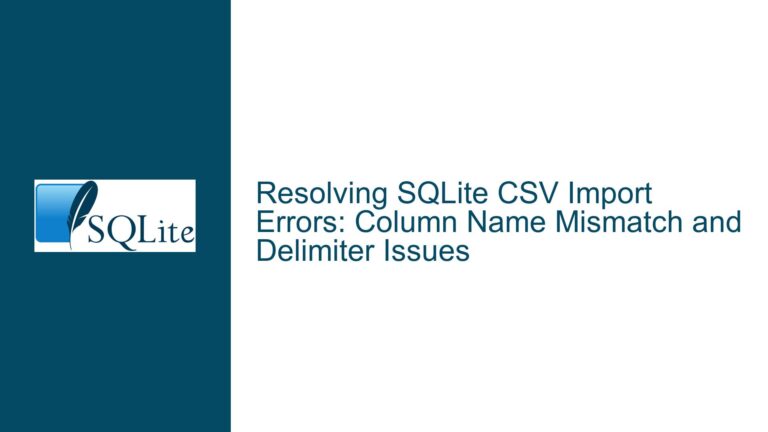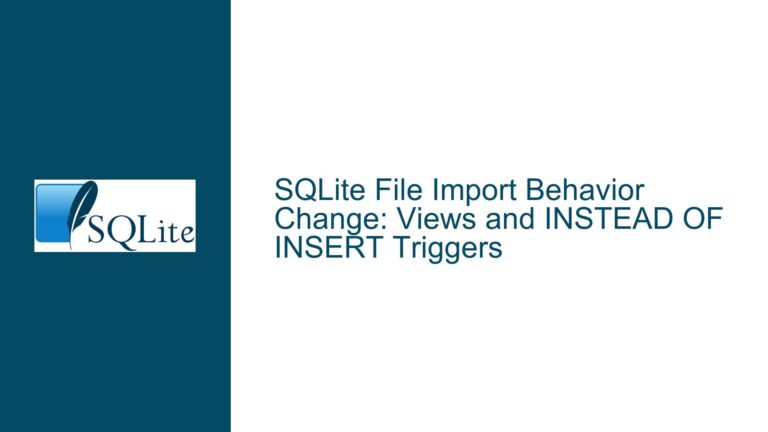Resolving System.OutOfMemoryException During Bulk SQLite Inserts in .NET
Issue Overview: Memory Exhaustion During Large Transaction Processing
The core problem arises when attempting to insert or modify extremely large datasets (e.g., 900,000+ rows) within a single SQLite transaction using a .NET Framework 4.7 application. The application crashes with a System.OutOfMemoryException, indicating that the process exceeds available memory resources. This occurs despite configuration adjustments in the SQLite connection string, including JournalMode=Memory, PageSize=65535, and CacheSize=16777216. The interaction between SQLite’s transaction mechanics, memory management in .NET, and misconfigured database parameters creates a perfect storm for memory exhaustion. The issue is exacerbated by SQLite’s architecture, which relies on contiguous memory allocation for transaction journals and page caching, particularly when handling bulk operations without proper optimization.
Possible Causes: Transaction Design and Configuration Missteps
1. Oversized Transactions and Journaling in Memory
SQLite requires a rollback journal or write-ahead log (WAL) to ensure atomicity and durability. When JournalMode=Memory is set, the journal resides entirely in RAM instead of being written to disk. For a transaction involving 900,000+ rows, the journal’s memory footprint grows proportionally to the volume of changes. Each modified row adds metadata and row data to the journal, consuming hundreds of megabytes (or gigabytes) of memory. This configuration directly contradicts the goal of handling large transactions efficiently.
2. PageSize and CacheSize Misconfiguration
The PageSize=65535 (64KB per page) and CacheSize=16777216 (16 million pages) settings create a theoretical cache size of 1 terabyte (16,777,216 pages × 65,535 bytes/page). While SQLite dynamically allocates cache memory based on usage, these values signal a misunderstanding of SQLite’s page cache mechanics. The default PageSize is 4096 bytes, and excessively large pages force SQLite to operate with fewer, larger I/O units, reducing efficiency and increasing memory pressure. The CacheSize parameter, when set to an unrealistic value, may lead to overcommitment of memory resources even if the actual usage is lower.
3. Lack of Batching and Unmanaged Object Disposal
Inserting 900,000+ rows in a single transaction forces SQLite to retain all modifications in memory until the transaction is committed. This approach ignores SQLite’s strength in handling smaller, batched transactions. Additionally, .NET’s garbage collector may fail to reclaim unmanaged resources (e.g., SQLiteCommand objects, SQLiteDataReader handles) in a timely manner, especially when these objects are not explicitly disposed. Memory fragmentation in the .NET heap can further aggravate the situation, making large contiguous memory blocks unavailable.
4. Legacy SQLite and .NET Framework Limitations
The use of SQLite 3.7.14.1 (released in 2012) with .NET Framework 4.7 introduces compatibility gaps. Older SQLite versions lack optimizations for bulk operations, such as improved memory reuse in prepared statements or WAL-mode enhancements. The .NET Framework’s 32-bit memory address space (if the application is compiled as x86) imposes a hard limit of 2–3 GB per process, making large transactions untenable.
Troubleshooting Steps, Solutions & Fixes
1. Restructure Transactions into Batches
Divide the 900,000-row operation into smaller transactions (e.g., 10,000–50,000 rows per batch). This reduces the memory footprint of the rollback journal and allows the garbage collector to reclaim memory between batches.
Implementation Example:
using (SQLiteTransaction transaction = cnSqlLite.BeginTransaction()) {
for (int i = 0; i < totalRows; i++) {
// Insert row
if (i % 10000 == 0) {
transaction.Commit();
transaction.Dispose();
transaction = cnSqlLite.BeginTransaction();
}
}
transaction.Commit();
}
Key Considerations:
- Use
BEGIN IMMEDIATEtransactions to avoid SQLITE_BUSY errors. - Ensure each batch is small enough to keep the journal in memory (if using
JournalMode=Memory) or within available disk space (for other journal modes).
2. Reconfigure Journal Mode and Synchronization
Replace JournalMode=Memory with JournalMode=Off or JournalMode=Wal to reduce memory pressure.
- JournalMode=Off: Disables the rollback journal entirely, sacrificing atomicity and durability for raw speed. Suitable for temporary databases or bulk imports where data loss is acceptable.
- JournalMode=Wal: Uses a write-ahead log, allowing concurrent reads and writes while spreading journal writes across multiple files. Reduces contention and memory usage for large transactions.
Connection String Adjustments:
conString.JournalMode = SQLiteJournalModeEnum.Wal; // or Off
conString.SyncMode = SynchronizationModes.Normal; // Balance speed and durability
Post-Configuration Steps:
- For WAL mode, periodically execute
PRAGMA wal_checkpoint(TRUNCATE)to prevent unbounded WAL file growth. - Avoid
JournalMode=Memoryfor transactions exceeding 100,000 rows.
3. Optimize Page and Cache Settings
Revert PageSize to the default 4096 bytes unless a specific workload justifies larger pages. Adjust CacheSize to a realistic value based on available memory.
Calculating CacheSize:
For a 2 GB cache with 4096-byte pages:
CacheSize = 2GB / 4096 = 524,288 pages
Revised Connection String:
conString.PageSize = 4096;
conString.CacheSize = 524288;
Additional PRAGMAs:
Execute these commands after opening the connection:
PRAGMA temp_store = MEMORY; -- Reduces I/O for temporary objects
PRAGMA mmap_size = 268435456; -- Allocates 256MB of memory-mapped I/O
4. Upgrade SQLite and Target 64-Bit Architecture
Replace SQLite 3.7.14.1 with version 3.45.1 or newer, which includes critical memory management improvements. Recompile the application for x64 to access the 64-bit address space, removing the 2–3 GB memory ceiling.
Migration Steps:
- Download the latest
System.Data.SQLitebinaries from sqlite.org. - Update project references to the new SQLite library.
- Set the build target to
x64orAnyCPU(prefer x64).
5. Implement Manual Memory Management in .NET
Explicitly dispose all SQLite-related objects and leverage using blocks to ensure timely resource cleanup.
Code Example:
using (SQLiteConnection cnSqlLite = new SQLiteConnection(conString.ToString())) {
cnSqlLite.Open();
using (SQLiteCommand command = cnSqlLite.CreateCommand()) {
command.CommandText = "INSERT INTO ...";
// Parameterized queries
command.ExecuteNonQuery();
}
} // Connection and command automatically disposed
Additional Measures:
- Use
GC.Collect()sparingly after large batch commits to force garbage collection. - Avoid caching
SQLiteParameterobjects; reuse them within batches but dispose afterward.
6. Evaluate External Storage for Temporary Data
For extremely large datasets, offload intermediate data to disk-backed structures (e.g., CSV files, Sqlite temporary tables with temp_store=FILE).
Temporary Table Strategy:
CREATE TEMP TABLE staging (id INTEGER, data BLOB); -- Stored in temp_store=FILE
-- Bulk insert into staging using batched transactions
INSERT INTO main.table SELECT * FROM staging;
7. Profile and Monitor Memory Usage
Use tools like ANTS Memory Profiler or dotMemory to identify memory leaks in the .NET layer. For SQLite-specific diagnostics, enable the SQLITE_CONFIG_LOG interface or use sqlite3_memory_used().
Diagnostic Queries:
PRAGMA stats; -- Shows memory usage statistics
PRAGMA compile_options; -- Verifies if SQLite is compiled with memory-saving options
8. Consider Alternative Storage Engines
If SQLite cannot be optimized further, evaluate embedded alternatives like Microsoft SQL Server Compact or LiteDB, which offer different trade-offs in transaction handling and memory management.
By systematically addressing transaction granularity, journaling strategies, memory configuration, and .NET resource management, developers can scale SQLite-based applications to handle millions of rows without triggering OutOfMemoryException. The interplay between SQLite’s configuration and .NET’s memory model requires careful tuning, particularly for legacy frameworks constrained by 32-bit addressing.






